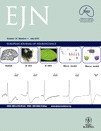Zamecnik J, Homola A, Cicanic M, Kuncova K, Marusic P, Krsek P, Sykova E, Vargova L. Eur J Neurosci. 2012 Jul;36(1):2017–24. doi: 10.1111/j.1460-9568.2012.08107.x. Epub 2012 Apr 26. IF: 3.631

Department of Pathology and Molecular Medicine
Abstract
Focal cortical dysplasias (FCDs) of the brain are recognized as a frequent cause of intractable epilepsy. To contribute to the current understanding of the mechanisms of epileptogenesis in FCD, our study provides evidence that not only cellular alterations and synaptic transmission, but also changed diffusion properties of the extracellular space (ECS), induced by modified extracellular matrix (ECM) composition and astrogliosis, might be involved in the generation or spread of seizures in FCD. The composition of the ECM in FCD and non-malformed cortex (in 163 samples from 62 patients) was analyzed immunohistochemically and correlated with the corresponding ECS diffusion parameter values determined with the real-time iontophoretic method in freshly resected cortex (i.e. the ECS volume fraction and the geometrical factor tortuosity, describing the hindrances to diffusion in the ECS). The ECS in FCD was shown to differ from that in non-malformed cortex, mainly by the increased accumulation of certain ECM molecules (tenascin R, tenascin C, and versican) or by their reduced expression (brevican), and by the presence of an increased number of astrocytic processes. The consequent increase of ECS diffusion barriers observed in both FCD type I and II (and, at the same time, the enlargement of the ECS volume in FCD type II) may alter the diffusion of neuroactive substances through the ECS, which mediates one of the important modes of intercellular communication in the brain – extrasynaptic volume transmission. Thus, the changed ECM composition and altered ECS diffusion properties might represent additional factors contributing to epileptogenicity in FCD.
-mk-
